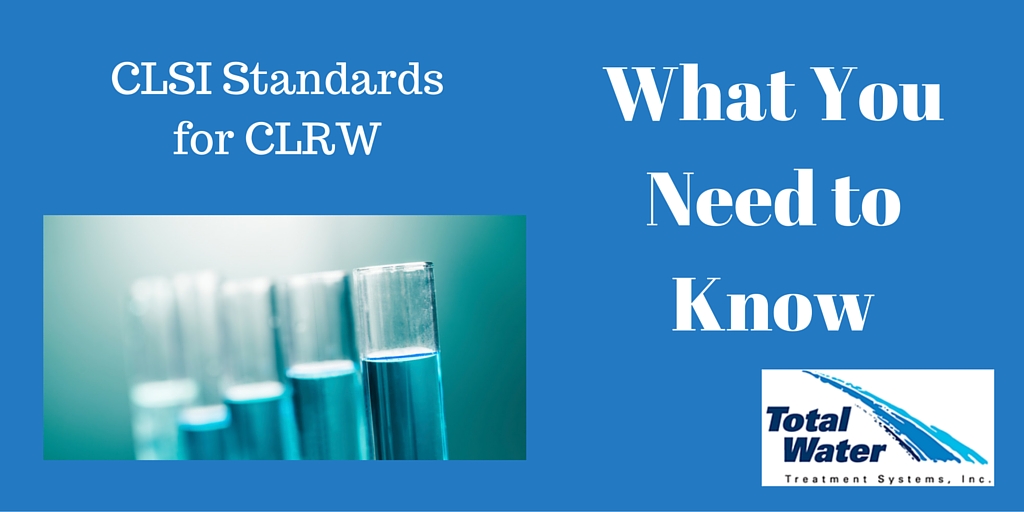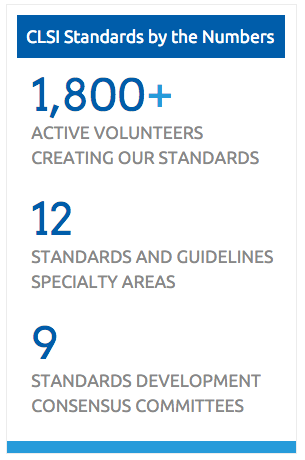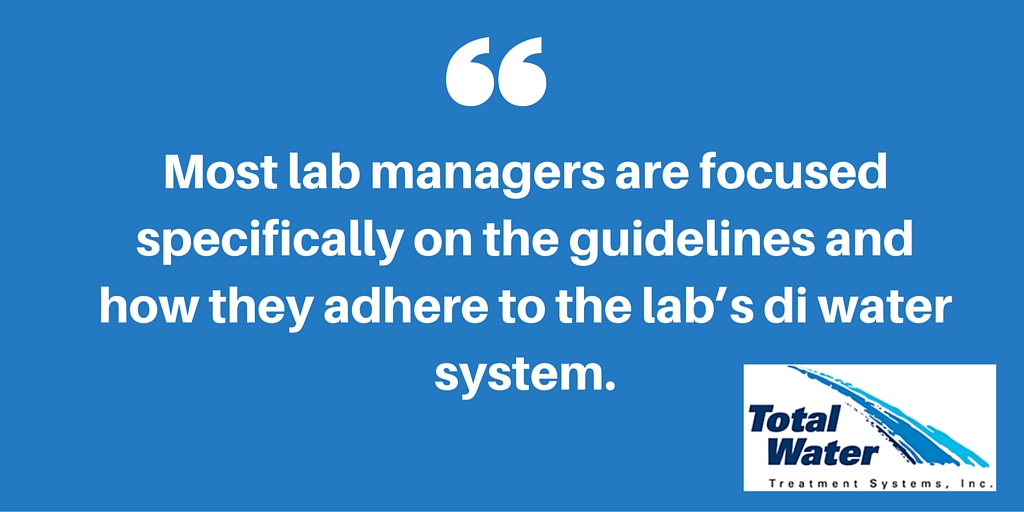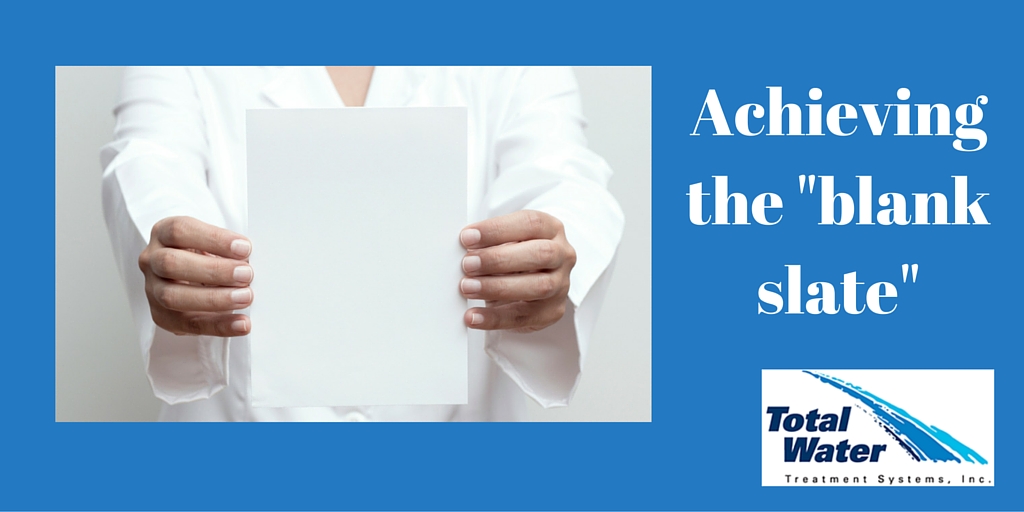Whether you’re designing a new water system for a clinical laboratory, or if you’re checking the quality of your current system, you’re going to have to know the basics of CLSI standards and guidelines for CLRW. We’ll provide you with an overview, including some ways to prevent problems before they occur.
Let’s first start with an overview of who sets the standards and guidelines – CLSI.
CLSI – Setting the Standards and Guidelines
The Clinical and Laboratory Standards Institute (CLSI), formerly known as NCCLS, describes itself as:
“An international, interdisciplinary, not-for-profit, standards-developing, and educational organization that promotes the development and use of voluntary consensus standards and guidelines within the healthcare community.”
Here’s a video that gives more background:
Global in scope, CLSI works with the laboratory community to “foster an excellence in laboratory medicine.” Their process for developing standards relies on input and consensus from industry, government and healthcare professionals.
CLSI has been setting the Standards and Guidelines. This snapshot from their website reveals the significant numbers:
What are CLSI Standards vs. CLSI Guidelines?
CLSI produces standards, guidelines and reports. When it comes to deionized water in a clinical laboratory setting, most lab managers are focused specifically on the guidelines and how they adhere to the lab’s di water system.
What exactly is a standard? Here is CLSI’s definition:
Standard: A document developed through the consensus process that clearly identifies specific, essential requirements for materials, methods, or practices for use in an unmodified form. A standard may, in addition, contain discretionary elements, which are clearly identified.
How does that compare to a Guideline? Again, from CLSI:
Guideline: A document developed through the consensus process describing criteria for a general operating practice, procedure, or material for voluntary use. A guideline may be used as written or modified by the user to fit specific needs.
While this guideline may be a “general” practice or procedure, there is very good reason for labs to follow it to the letter.
Why Deionized Water in the Lab Should be a “Blank Slate”
In June of 2006, CLSI published “Preparation and Testing of Reagent Water in the Clinical Laboratory; Approved Guideline – Fourth Edition.” We’ll highlight some of the changes from the guideline, and in future posts, we’ll delve deeper into some of the details.
But if a guideline is “general” in nature, why we do stress adhering to it so closely?
As we’ve detailed on our deionized water page, the accuracy of a clinical laboratory’s results will depend, in part, on the purity of its di water.
Deionized water in its purest state is free of charged ions. The industry norm is around 10 megohms resistivity (Total Water’s is 18.2 megohms). The goal is to achieve a “blank slate,” so the water can take on the characteristics of any solution or chemistry that is added.
The guidelines in this document are all required to ensure the “blank slate” is possible. The closer you follow them, the more accurate your results.
Differences From Previous CLSI Guidelines
CLSI notes a series of changes in the Clinical Laboratory Reagent Water (CLRW) guideline. If you’ve purchased a new purified water system since this was published in 2006, or if you’ve changed your current system, you may be aware of these.
If you haven’t and you’re now wondering if you’re meeting some of the guidelines, let’s take a closer look at some of the main changes:
1. CLRW can be used in place of Type I and Type II water
“The Type I, II, and III designations for types of purified laboratory water, used in the previous edition, have been replaced with purity types that provide more meaningful specification for clinical laboratory testing,” the guideline indicates.
Clinical Laboratory Reagent Water can now be used in place of Type I and II water for most applications. Autoclave and wash water will generally be a satisfactory replacement for Type III water.
2. Total Organic Carbon (TOC) parameter has been added
Perhaps the most significant change of this guideline is the addition of the TOC parameter. CLSI recommended that water purification systems reduce organic contamination, but it required no control.
Recognizing how organic contamination can be introduced by components of water purification systems (among other factors), TOC parameters were established. Systems that have PVC piping, for example, have to be sealed correctly to prevent glue-sealant from entering the water.
3. Plate counting of colonies continues to be the specified approach
Epifluorescence and endotoxin testing have been added as optional tests, the guideline notes.
4. Weakly ionized contaminants
According to the guideline, “Specifications and methods for measuring pH and silicates, as SiO2, have not been carried forward from the previous edition.” It’s noted that resistivity is not a sensitive indicator of weakly ionized contaminants (such as silica) but that their release can be avoided by appropriate design and regular maintenance of ion-exchange components.
5. The parameters for quality control
The guideline notes some of the following parameters:
The basic specifications for CLRW are:
- 10 cfu/ml for bacterial contamination
- Resistivity of 10 megaohm@25C as dispensed
- A final filter of a minimum of .22 microns
- Organic impurities at less than 500 ppb
Six types of Reagent Water are specified:
- Clinical laboratory reagent water (CLRW)
- Special reagent water (SRW)
- Instrument feed water
- Water supplied by a method manufacturer
- Autoclave and wash water
- Commercially bottled, purified water
All must begin with potable water.
The guideline establishes three parameters for measuring purified water in clinical laboratory applications:
- Resistivity: An indicator of ionic contamination
- Total organic carbon: An indicator of organic contamination
- Viable plate counts: An indicator of micro-organism contamination
Finally, the guideline notes:
“Any parameters used to specify a type of purified water, or to monitor the performance of a purification system, must be measured frequently enough to detect potential changes in the system, and the measurement results should be monitored for trends to anticipate maintenance before the water quality degrades to a point that will cause problems with laboratory testing.”
If you’re curious about whether or not you’re meeting the parameters specified in the CLSI guideline for water purification system validation, ongoing maintenance, and revalidation on a recurring schedule, take advantage of our Free Water Standards review.
We’ll do more than give you a quote—we’ll visit your site to analyze your industrial water needs.





Follow Us